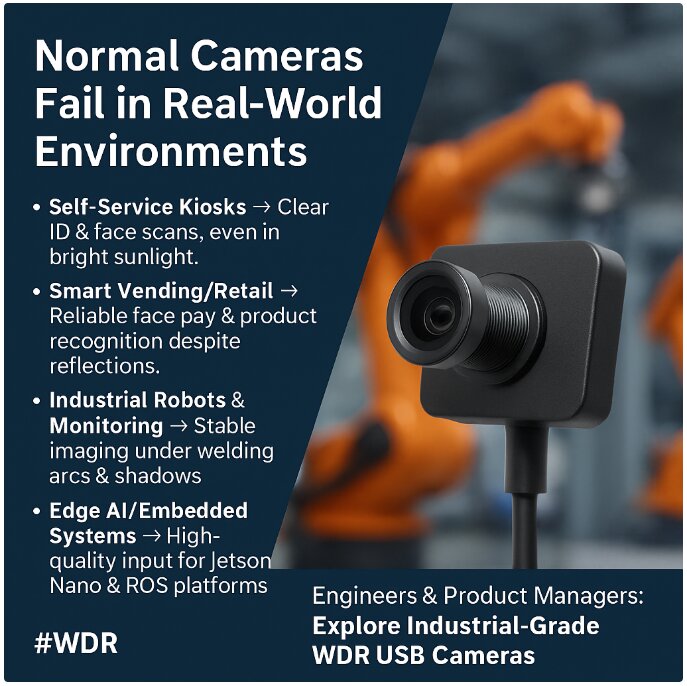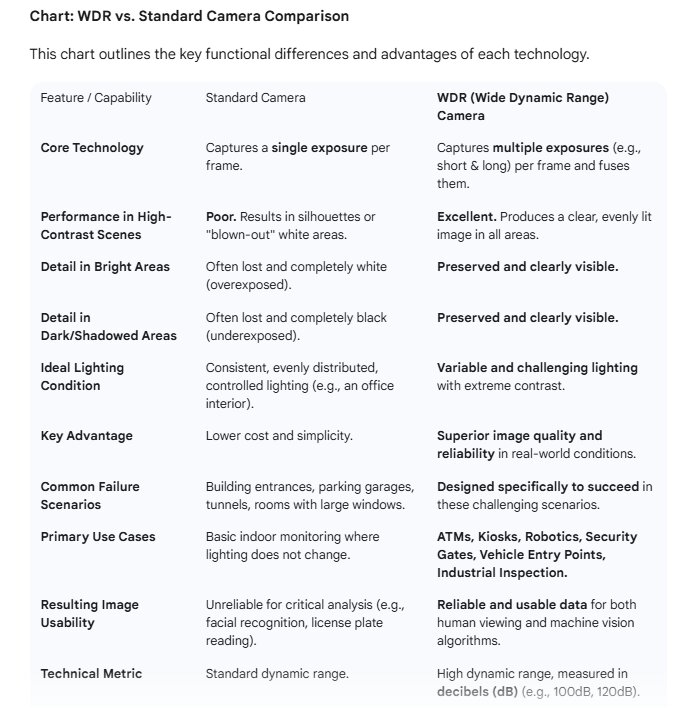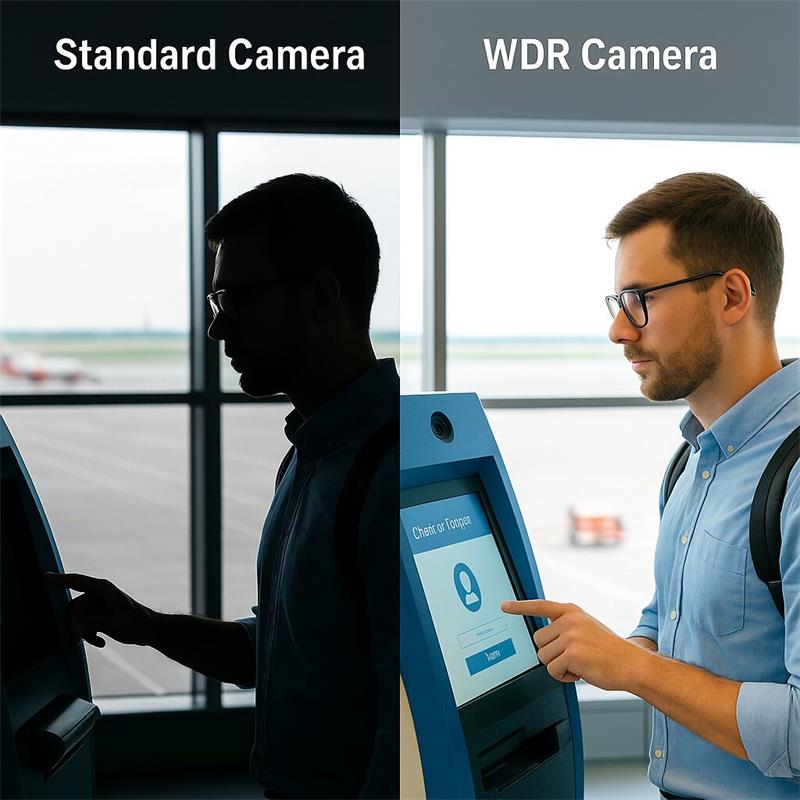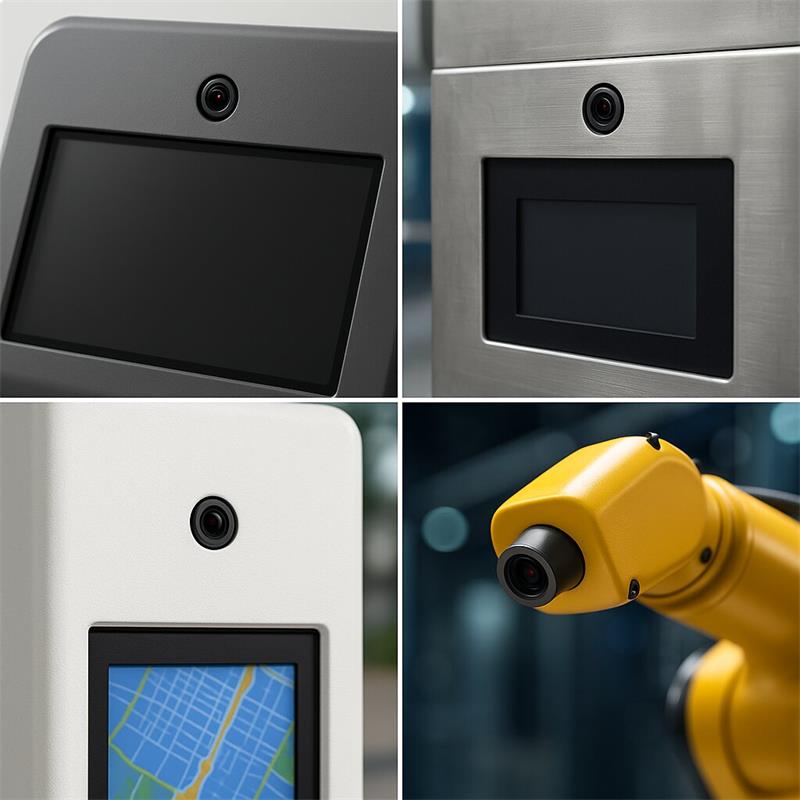
(A Practical Guide: WDR vs. Standard Cameras)
Picture this: You’re at an airport, late for a flight. You walk up to a sleek self-service check-in kiosk. The software is designed for smooth, instant check-in with face recognition. But the sun streams in through the massive glass wall behind you. The kiosk’s normal USB camera can’t cope—your face turns into a dark silhouette against the backlight. After three failed attempts, you abandon the kiosk in frustration.
This isn’t a software bug. It’s a backlight camera problem. Standard cameras simply cannot handle high-contrast scenes. And for engineers and product managers building kiosks, vending systems, or industrial robots, this problem has real-world consequences: lost transactions, broken trust, and frustrated users.
To understand why this happens, we need to talk about dynamic range—the difference between the darkest and brightest areas a camera can capture in a single image.
Normal USB cameras use a single exposure to capture light. That works fine in evenly lit environments.
But in real-world conditions—like sunlight streaming through a window, or shadows in a factory—single exposure means a trade-off:
Bright areas get blown out into pure white.
Dark areas disappear into black.
That’s why in a normal USB camera vs industrial camera comparison, the difference isn’t about resolution but about adaptability to contrast.
Example: In backlit environments, a user’s face becomes unrecognizable. For robots, small parts under shadowed conveyor belts go unseen. For vending machines, customer faces inside shaded areas are impossible to identify for payment or age verification.

In simple terms, Wide Dynamic Range (WDR) is a technology that allows a camera to capture clear and balanced images in scenes that have both very bright and very dark areas at the same time.
To understand WDR, it's best to start with an analogy: the human eye. When you stand indoors and look out a bright window, your eyes can adjust to see details on the person standing in front of the window and the scenery outside. A standard camera fails at this task; it can only choose one. The result is either a dark silhouette of the person or a completely white, washed-out view of the window. WDR technology gives a camera vision that is much closer to that of the human eye.
A camera's "dynamic range" refers to the ratio between the lightest and darkest tones it can capture in a single frame.
A standard camera has a narrow dynamic range. When faced with a high-contrast scene, it is forced to make a compromise. If it exposes for the bright areas, the dark areas become black (underexposed). If it exposes for the dark areas, the bright areas become completely white (overexposed). In both cases, crucial image information is permanently lost.
True, hardware-based WDR solves this problem by capturing more information than a single exposure can provide. It works through a process of multi-exposure imaging and tone mapping:
Rapid Multi-Exposure: The camera's sensor captures at least two (and sometimes more) frames of the same scene in rapid succession, each at a different exposure level.
Short Exposure (Underexposed): One frame is captured with a very fast shutter speed. This prevents the bright areas of the scene (like a sunny window or a lightbulb) from becoming overexposed, preserving all the details within them.
Long Exposure (Overexposed): Another frame is captured with a slower shutter speed. This allows more light to hit the sensor, capturing all the hidden details within the darkest, shadowed areas of the scene.
Intelligent Image Fusion: An advanced Image Signal Processor (ISP) inside the camera takes these multiple frames. It analyzes them and intelligently combines the best-lit parts of each frame.
Tone Mapping: The processor then "tone maps" the fused image, compressing the wide range of brightness into a final image that looks clear, natural, and evenly lit on a standard display.
The result is a single, clear image where details in both the shadows and the highlights are visible and sharp. The effectiveness of WDR is often measured in decibels (dB); a higher dB value (e.g., 120dB) indicates a stronger ability to handle extreme lighting contrast.
It's important to distinguish this from Digital WDR (DWDR), which is a software-based technique that uses algorithms to artificially brighten dark areas of a single-exposure image. It cannot recover lost details and is far less effective than the true, hardware-based WDR described above.

Enter WDR (Wide Dynamic Range) cameras. Imagine a camera that, like the human eye, adjusts to extreme lighting conditions and still delivers usable detail. That’s exactly what WDR technology does.
True WDR (Multi-Exposure WDR): The sensor captures multiple frames at different exposure levels (short for bright areas, long for dark areas) and fuses them into one balanced image. The result? A clear picture where both shadows and highlights are visible.
Digital WDR (DWDR): Software-based processing that tries to “fix” contrast after the fact. This often looks artificial and loses detail.
For engineers, the difference is critical. A true WDR camera module 120dB can handle lighting variations from sunlight to shadows seamlessly, while a DWDR solution simply cannot.
Side-by-side comparisons (WDR off vs WDR on) are often the most powerful proof: where the standard camera fails, the low light WDR USB camera succeeds.

The Challenge: Bright lobbies, glass walls, and reflective lighting create glare and shadows. Customers struggle with ID scans and face recognition.
The WDR Solution: A micro USB camera module with WDR ensures clear capture of faces, IDs, or QR codes, regardless of backlight or glare. It can be embedded invisibly in the slim black bezel above the kiosk display.
Value: Fewer failed transactions, smoother user flow, and kiosks that work in any environment—airports, malls, outdoor stations.
The Challenge: Indoor vending machines face overhead lights; outdoor vending kiosks face sunlight and shadows. Glass doors create reflections that cause recognition errors.
The WDR Solution: A dedicated vending machine camera with anti-glare USB camera module design provides accurate face payment, ID verification, and reliable product scanning.
Value: Trustworthy, unattended retail experiences, higher customer satisfaction, and new revenue opportunities.
The Challenge: In factories, welding arcs and dark corners coexist. Standard cameras either overexpose sparks or lose detail in shaded areas.
The WDR Solution: Industrial-grade low light WDR USB cameras capture fine product details and gauge readings in extreme conditions. They can be mounted on robotic arms, inspection panels, or embedded into equipment.
Value: Higher AOI (automated optical inspection) accuracy, fewer undetected errors, and reduced downtime.
The Challenge: AI and robotics live on data. Garbage in, garbage out. Poor image quality leads to misclassification and failed AI outcomes.
The WDR Solution: A Jetson Nano compatible WDR camera or ROS compatible USB camera ensures AI frameworks get stable, high-quality input. Add UVC plug-and-play support for Linux, and engineers save weeks in integration.
Value: Faster deployment, more accurate recognition, and longer-lasting robotic reliability.

A micro USB camera module with WDR in 15×15mm size allows integration into tight spaces—robot grippers, vending machine bezels, or kiosk frames—without compromising aesthetics.
UVC camera modules for smart terminals mean no driver headaches. Plug into Linux, Windows, or Jetson boards and start streaming instantly in OpenCV or ROS.
From custom lenses to cable lengths and mounting designs, OEM USB camera module for kiosks can be tailored for unique deployments. Engineers save time, while businesses get differentiation.
In modern automation, lighting is unpredictable. Whether in a sunlit lobby, a factory full of glare, or an outdoor vending environment, your device’s success depends on what it sees.
A low light WDR USB camera is not just “better”—it is the difference between frustration and satisfaction, between failed projects and scalable deployments.
Call to Action: Ready to see how WDR transforms your next project? Explore our industrial-grade WDR USB cameras today or connect with our engineering team to discuss your custom application